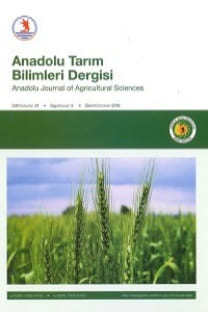Buğdayda polimeraz zincir reaksiyonu ve olası sorunların optimizasyonu
Polymerase chain reaction in wheat and optimization of the possible problems
___
- Akar, N., 1999. Polimeraz Zincir Reaksiyonu. Pediatrik Moleküler Patoloji ve Genetik.http://www.medicine.ankara. edu.tr/internalmedical/pediatrics/molgen/ index.
- Anonim, 2004. Polymerase Chain Reaction(PCR). http://www.karymullis.com/pcr.
- Anonim, 2005. PCR Generalities. Standard PCR Reaction Mix. http://www.info.med.yale.edu/genetics.
- Bock, R., 1997. Biolistic Transformation of plants with anion-exchange-purified plasmid DNA. Qiagen News. Issue No:5. Institut für Biologie III, Universitat Freiburg, Germany.
- Eckert, K.A. and Kunkel, T.A., 1990. High fidelity DNA synthesis by the Thermus aquaticus DNA polymerase. Nucleic Acids Res. 18: 3739-3744.
- Ellsworth, D.L., 1993. Artifactual variation in randomly amplified polymorphic DNA banding patterns. BioTechniques, 14: 214-217.
- Henegariu, O., Heerema, N.A., Dlouhy, S.R., Vance, G.H. and Vogt, P.H., 1997. Multiplex PCR: Critical Parameters and Step-by-Step Protocol. BioTechniques, 23: 504-511.
- Karcicio, M., 2007. Uygulamalı Gen Amplifikasyonu: PCR Teknolojisi. Polimeraz Zincir Reaksiyonu (PCR). Bio 954.http://yunus.hacettepe.edu.tr/~coner.
- Maxam, A., and Gibert, W., 1977. A new method Sequencing DNA. Proceeding of the National Acedemy of Sciences, 74: 560-564.
- Promega, 2004. General Considerations for PCR Optimization. Protocols and Applications. Chapter 1: Nucleic Acid Amplification.
- Qiagen, 2005. Critical Factors for Successful PCR. Primer Annealing and PCR buffers. http://www.qiagen.com.
- Roberts, R.J., 1987. Restriction and Modification Enzymes and Their Recognition Sequences. Gene Amplif Anal, 5: 1-49.
- Sambrook, J., Fritsch, E.F., Maniatis, T., 1989. Molecular Cloning, A Laboratory Manual. Cold Spring Harbor Laboratory Press, New York.
- Sanger, F., Nicklen, S., Coulson, A.R., 1977. DNA Sequencing with Chain-Terminating Đnhibitors. Proceeding of the National Academy of Sciences, 7: 5463-5467.
- Somers, D.J., Isaac, P., Edwards, K., 2004. A high-density microsatellite consensus map for bread wheat (Triticum aestivum L.). Theor Appl Genet., 109: 1105-1114.
- Southern, E.M., 1975. Detection of Specific Sequences Among DNA Fragments Separated by Gel Electrophoresis. Journal Molecular Biology, 98: 503- 517.
- Watson, D.J., Gilman, M., Witkowski, J., Zoller, M., 1992. Recombinant DNA. Scientific American Books, s:63- 75, New York.
- Weining, S. and Langridge, P., 1991. Identification and Mapping of Polymorphism in Cereals Based on the Polymerase Chain Reaction. Theor. Appl. Genet., 82: 209-216.
- Williams, J.F., 1989. Optimization Strategies for the Polymerase Chain Reaction. Biotechniques, 7: 762-769
- ISSN: 1308-8750
- Yayın Aralığı: 3
- Başlangıç: 1986
- Yayıncı: Ondokuz Mayıs Üniv. Ziraat Fak.
Miray Arlı SÖKMEN, İlyas DELİGÖZ
ŞEKER PA CARI SULAMA ZAMA I BELİRLE MESİ DE BİTKİ SU STRES İ DEKSİ İ
Tokat ili sebze alanlarındaki kök-ur nematod (Meloidogyne spp.)’ larının yayılısları ve tür tespiti
KÜRESEL ISI MA I BÖCEKLERE ETKİLERİ
Kuzu doğum ağırlığının semitendinosus kasındaki lif sayısı ve çesidine etkisi
Emre SİRİN, Yüksel AKSOY, Zafer ULUTAS, Mehmet KURAN, Uğur SEN
TURU ÇGİL ARAŞTIRMALARI DA BİYOTEK OLOJİ ÇALIŞMALARI
Turunçgil arastırmalarında biyoteknoloji çalısmaları
Seyit Ali KAYIS, Ufuk KARADAVUT, İsmail KESKİN
